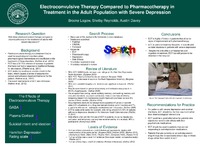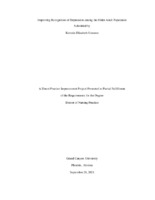| dc.contributor.author | Lagow, Brooke | en |
| dc.contributor.author | Reynolds, Shelby | en |
| dc.contributor.author | Davey, Austin | en |
| dc.date.accessioned | 2016-03-17T11:56:22Z | |
| dc.date.available | 2016-03-17T11:56:22Z | |
| dc.date.issued | 2016-03-17 | |
| dc.identifier.uri | http://hdl.handle.net/10755/601471 | en |
| dc.description | <p>Caring for a Diverse World</p> | en |
| dc.description.abstract | <p><strong>Background:</strong> Electroconvulsive therapy (ECT) is a treatment that is used for psychological disorders when pharmacological interventions are insufficient in treatment of these disorders. ECT is a very effective treatment that has a success rate between 50-70%, even in patients that have not responded to treatment with medications. ECT works by sending an electric shock to the brain, which induces seizures and corrects and enhances patient mood and behavior. The exact mechanisms of ECT are unknown.</p>
<p><strong>Purpose: </strong>The purpose of the literature review was to explore how ECT compares with pharmacotherapy in the severely depressed adult.</p>
<p><strong>Methods:</strong> A literature review was conducted through the Jacksonville University Library database, which granted access to articles from PubMed, CINAHL, and ProQuest. Twelve articles were reviewed and ten articles were utilized in the review. Eight of the articles were individual experimental studies, one article was a non-experimental comparative study, and the last article used was a review of literature.</p>
<p><strong>Findings/Implications:</strong> The literature review showed that ECT is highly effective in patients that show no signs of improvement with pharmacotherapy. ECT is useful in decreasing thoughts of suicide and suicidal ideations in patients with severe depression. Despite these findings, clinical documentation shows that ECT is prescribed only to a small group of patients. It is appropriate to prescribe ECT for patients that have suicidal thoughts and ideations as a first line in treatment rather than a last option. ECT would also be beneficial for patients that experience severe side effects with their medications or patients that are not responding to their medications.</p> | en |
| dc.format | Text-based Document | en |
| dc.language.iso | en_US | en |
| dc.subject | Severe Depression | en |
| dc.subject | Electroconvulsive Therapy | en |
| dc.title | Electroconvulsive therapy compared to pharmacotherapy in treatment in the adult population with severe depression | en |
| dc.type | Poster | en |
| dc.rights.holder | <p>
All rights reserved by the author(s) and/or publisher(s) listed in this item record unless relinquished in whole or part by a rights notation or a Creative Commons License present in this item record.
</p><p>
All permission requests should be directed accordingly and not to the Sigma Repository.
</p><p>
All submitting authors or publishers have affirmed that when using material in their work where they do not own copyright, they have obtained permission of the copyright holder prior to submission and the rights holder has been acknowledged as necessary.
</p> | |
| dc.type.category | Full-text | en |
| dc.evidence.level | N/A | en |
| dc.research.approach | N/A | en |
| dc.contributor.department | Non-member | en |
| dc.author.details | Brooke Lagow; Shelby Reynolds; Austin Davey | en |
| dc.conference.name | STTI Lambda Rho Chapter’s 2016 Nursing Research Conference | en |
| dc.conference.host | Lambda Rho at-Large Chapter of Sigma Theta Tau International Honor Society of Nursing | en |
| dc.conference.location | Jacksonville, Florida, USA | en |
| dc.date.conferenceyear | 2016 | |
| dc.description.reviewtype | Abstract Review Only: Reviewed by Event Host | en |
| dc.description.acquisition | Proxy-submission | en |





